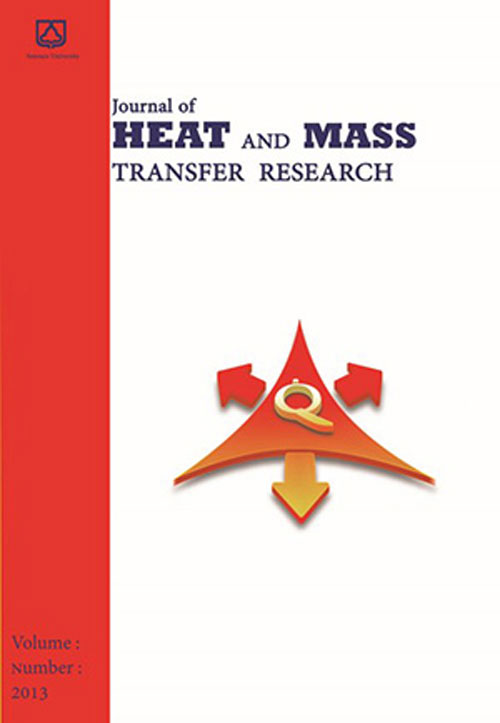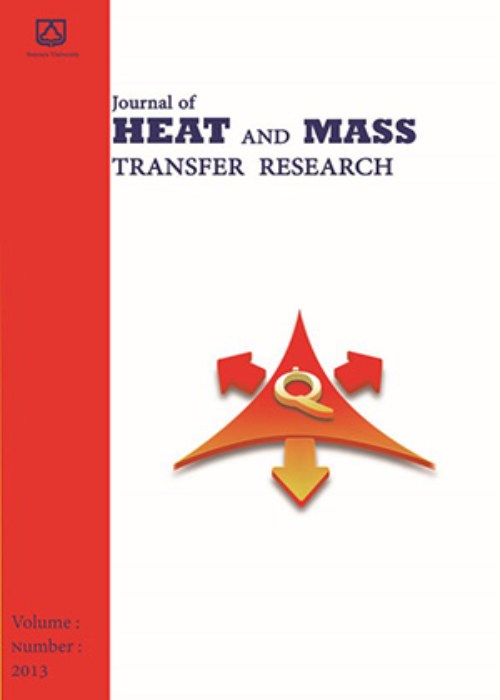فهرست مطالب

Journal of Heat and Mass Transfer Research
Volume:6 Issue: 2, Summer-Autumn 2019
- تاریخ انتشار: 1398/07/09
- تعداد عناوین: 7
-
-
Pages 75-84In the present work, the performances of improved two-stage multi inter-cooler trans- critical carbon dioxide (CO2) refrigeration cycles with ejector and internal heat exchanger have been examined. In the new improved cycles, an internal heat exchanger is append to the cycles. Also, second inter-cooler in improved cycles, cooled with the refrigeration of the cycle, so that in first cycle it is a branch of saturated vapour flow from separator and in second cycle it is a branch of supersaturated steam from internal heat exchanger as well. Results are validated against those available in the literature. Comparisons of the results indicate that there is an excellent agreement between them. The influences of important operational parameters in the cycle performance such as pressure of gas-cooler, temperature of evaporator and temperature of gas-cooler on the performance of cycle have been analysed. The obtained results present that if the cooling flow for second inter-cooler supply from saturated vapour from separator, maximum coefficient of performance can be improved 25% in comparison with the conventional cycle at the considered specific states for operation.Keywords: Trans-critical, refrigeration, Carbon dioxide, multi inter-cooler, internal heat exchanger
-
Pages 85-93Liquid paraffin as a coolant fluid can be applied in electronic devices as a result to its suitable capabilities such as electrical insulating, high heat capacity, chemical and thermal stability, and high boiling point. However, the poor thermal conductivity of paraffin has been confined its thermal cooling application. Addition of high conductor nanoparticles to paraffin can fix this drawback properly. In this article, the influence of the nanoparticles on the thermal conductivity of base material was assessed. Temperature (20-50°C) and volume fractions (0-3%) effect on the thermal conductivity of paraffin/alumina nanofluids have been considered. Nanofluid samples were prepared applying the two-step method. The thermal conductivity was measured by a KD2 pro instrument. The results indicated the thermal conductivity augments smoothly with an increase in volume fraction of nanoparticles as well as temperature. Moreover, it observed that for nanofluids with more volume-fraction the temperature affection is more remarkable. Thermal conductivity enhancement (TCE) and effective thermal conductivity (ETC) of the nanofluid was calculated and new correlations were reported to predict the values of them based on the volume fraction of nanoparticles and temperature of nanofluid accurately.Keywords: Experimental correlation, Alumina, Liquid paraffin, Nanofluid
-
Pages 95-103The objective of current paper is 3D simulation of turbulent, developing flow and unsteady within a circular duct in presence of the body force vector persuaded by Dielectric barrier discharge (DBD) plasma actuator inside the surface of geometry for the first time. This article aims at investigating of applying plasma actuator to control separation with special arrangement of electrodes. For this reason, the plasma actuator is modeled in OpenFOAM software and the results are validated.Subesequently, to examine the effect of the presence of the plasma actuator a numerical study is carried out on a 3D flow. The physics of the problem is determined by three phenomena of increasing the flow cross-sectional, developing flow and simultaneous flow in both radial and tangential directions, especially the pressure gradients. As a result of the geometry of the problem, the actuators are arranged differently and the electrodes are arranged in radial direction. The results indicate that plasma actuator delay the separation point.Keywords: Plasma Actuator, Active Flow Control, Flow Separation, Unsteady Flow, Developing Flow
-
Pages 105-116In this article, a two dimensional pore scale model of polymeric fuel cell, which is promising of a clean and renewable energy production, is presented here. Let reactive gases behave as an ideal gas; inhomogeneous anisotropic structure of the gas diffusion layer, is contemplated as a random generated circular porous media. Lattice Boltzmann method is applied to inquire the fluid flow and mass transfer within the cathode microstructure. All parts of the cathode have the same temperature and the electrochemical reaction on the surface of the catalyst layer enters the solution as a boundary condition. Effects of the gas diffusion layer structure (carbon fibers diameters changes) on the flow of reactive gases, molar fraction of various oxygen species, and water vapor within the various parts of the gas diffusion layer as well as the electrical current density are investigated. The results indicate that by increasing the diameter of the carbon fibers in the gas diffusion layer within constant porosity facilitates both the flow of oxygen and the vapor species inside the GDL, while affecting the produced electrical current on the surface of the catalyst layer.Keywords: GDL construction, Reactants distribution, Electrical current density, PEMFC
-
Heat and mass transfer of nanofluid over a linear stretching surface with Viscous dissipation effectPages 117-124
Boundary Layer Flow past a stretching surface with constant wall temperature, of a nanofluid is studied for heat transfer characteristics. The system of partial differential equations describing such a flow is subjected to similarity transformations gives rise to a boundary value problem involving a system of ordinary differential equations. This system is solved by a shooting method. Effect of the non-dimensional parameters on temperature and concentration profiles are displayed graphically for different values of the parameters, namely, Brownian motion parameter, Lewis number, Prandtl number and thermophoresis parameter. The reduced Nusselt number and the reduced Sherwood number are also shown in a tabular form. The main objective of this paper is to extend the numerical investigation of boundary-layer flow of steady state, two-dimensional flow of nanofluid over a stretching surface with the impact of viscous dissipation. The ordinary differential equations are obtained by applying similarity transformation on partial differential equations. Then, the system is solved by applying the shooting techniques together with Adams-Bashforth Moulton Method. Software Fortran is used to compute the numerical results and the resulting values are indicated through graphs and tables.
Keywords: Stretching Sheet, Nanofluid, Boundary Layer, Brownian motion, Thermophoresis, viscous dissipation -
Pages 125-132Analytical solutions have been obtained for both conservative and non-conservative forms of one-dimensional transport and transport-dispersion equations applicable for pollution as a result of a non-conservative pollutant-disposal in an open channel with linear spatially varying transport velocity and nonlinear spatially varying dispersion coefficient on account of a steady unpolluted lateral inflow in accordance to the channel. A logarithmic transformation in the space variable has been applied in order to derive a general solution of the transport equation for spatially variable initial pollutant distribution and upstream time-dependent pollutant concentration. The logarithmic transformation reduces both conservative and non-conservative forms of transport-dispersion equation to a form with constant coefficients that is solvable by analytical methods. An analysis of these solutions indicates that only the solution of a conservative form of the governing equation yields appropriate results that are conceptually acceptable in a real physical situation. The solution lends to analyze the damping effect of such transport on the pollutant with an initial Gaussian profile, in contrast with that of the initial quasi-Gaussian profile available in the literature. It is noteworthy to mention that the solution of conservative form of the transport equation implies that mass of the non-conservative pollutant in the channel decreases with an increase in time, and finally reaches to a constant value that is a ratio of product of the transport velocity coefficient and upstream concentration to the coefficient of decay of the pollutant.Keywords: Transport, dispersion, logarithmic transformation, one-dimensional, non-conservative pollutant
-
Pages 133-141In this research, turbulent MHD convection of liquid metal with constant and variable properties is investigated numerically. The finite volume method is applied to model the fluid flow and natural convection heat transfer in a square cavity. The fluid flow and heat transfer were simulated and compared for two cases constant and variable properties. It is observed that for the case variable properties in high Hartmann numbers (Ha) the temperature slope near the hot wall is more than the cold wall. For both cases, the temperature gradient near the hot and cold walls is high. By applying magnetic field and increasing the Ha the temperature slope reduces so at Ha=800 the profile is linear. In the case constant properties, the slope of temperature profile near the vertical walls is the same and the temperature profiles pass from one point at the center of the cavity. However,in the case variable properties as it was expected the temperature profile doesn’t pass one point and the slope of temperature profile at high Hartmann numbers near the hot and cold walls is partly different. Furthermore, it is indicated that for the case constant properties the Nusselt number is less than the case variable properties.Keywords: Free convection, Variable properties, Magnetic field, turbulent flow


